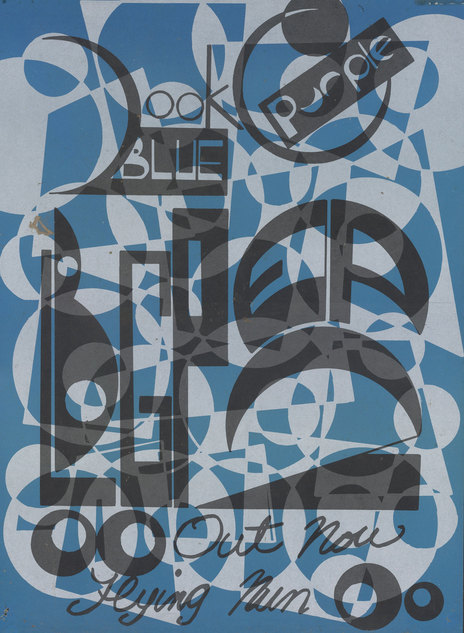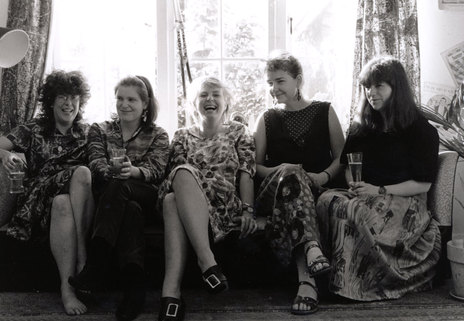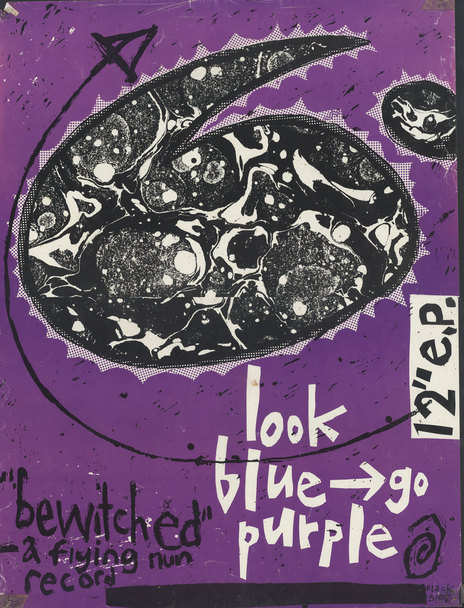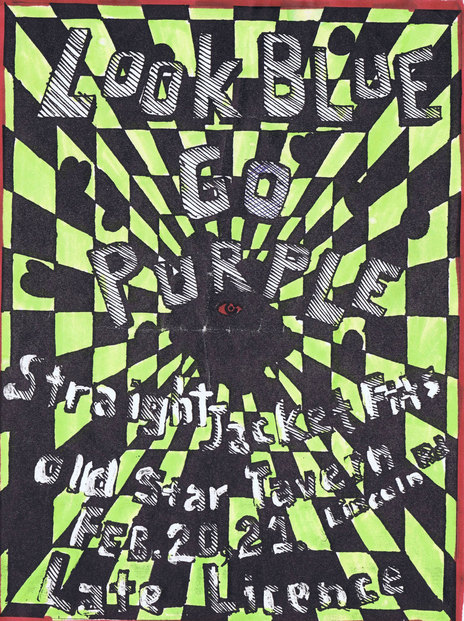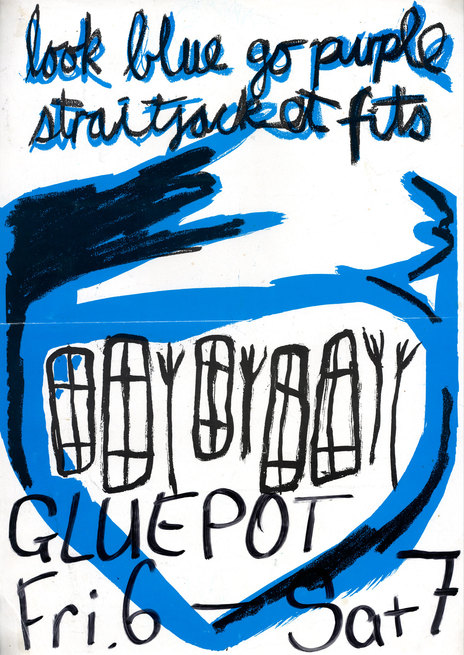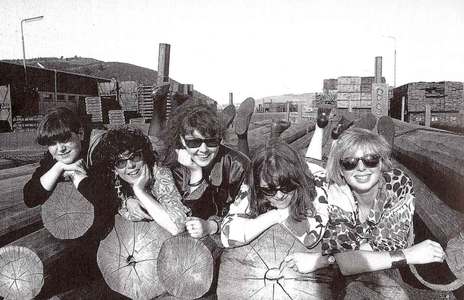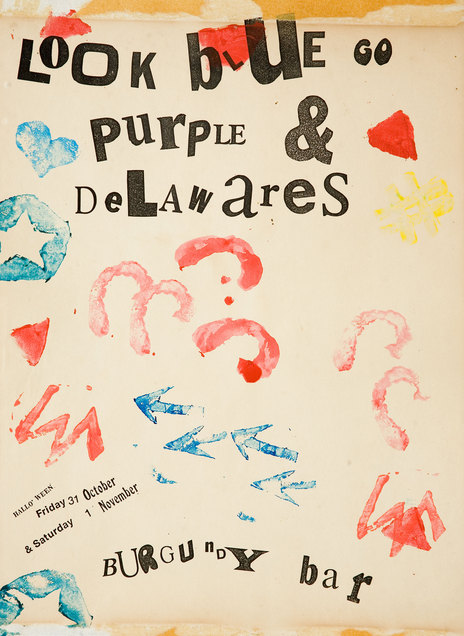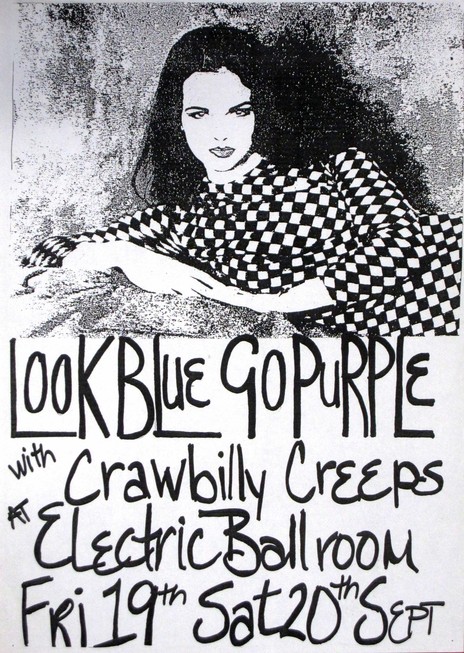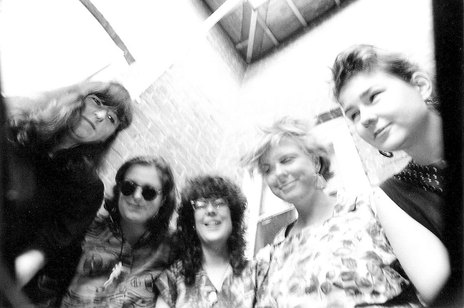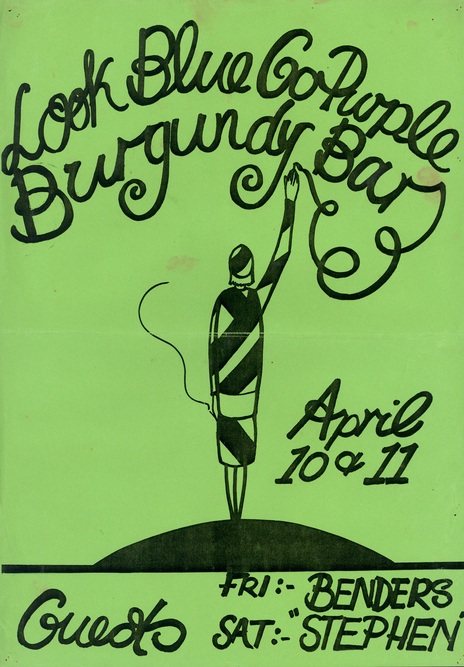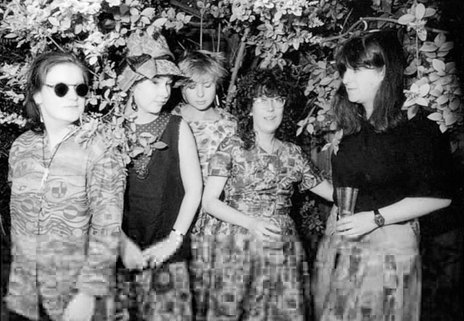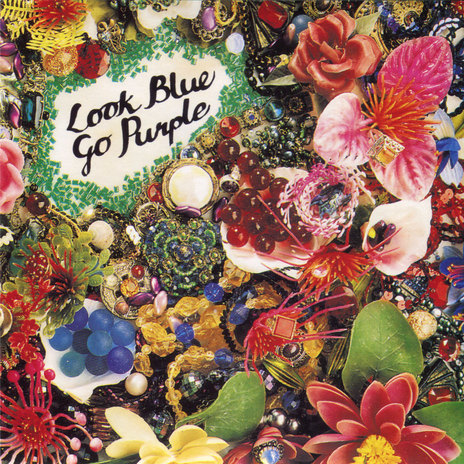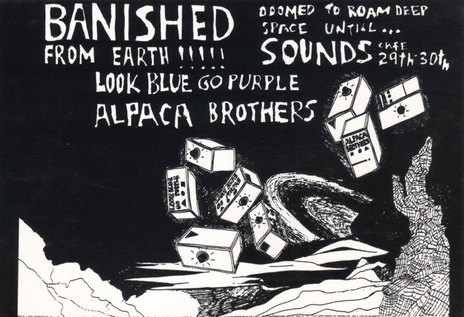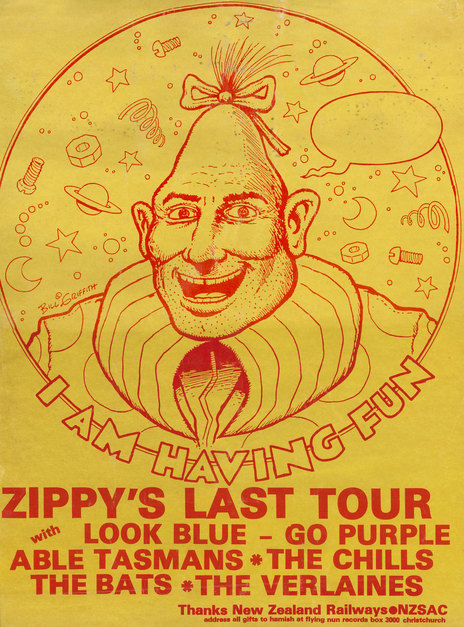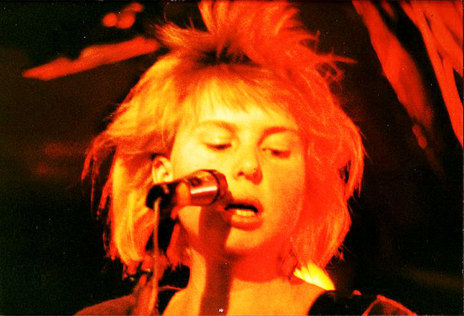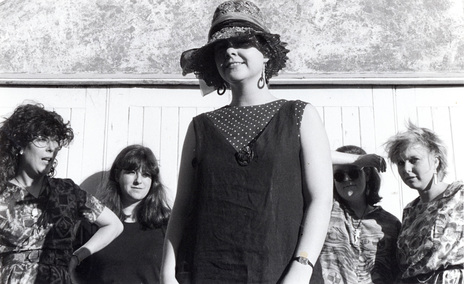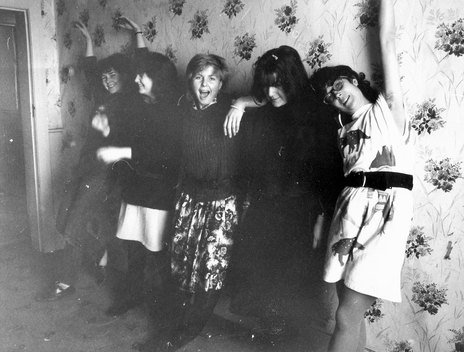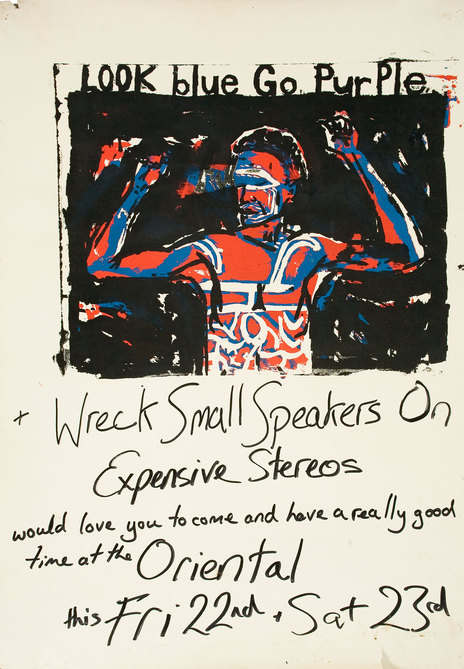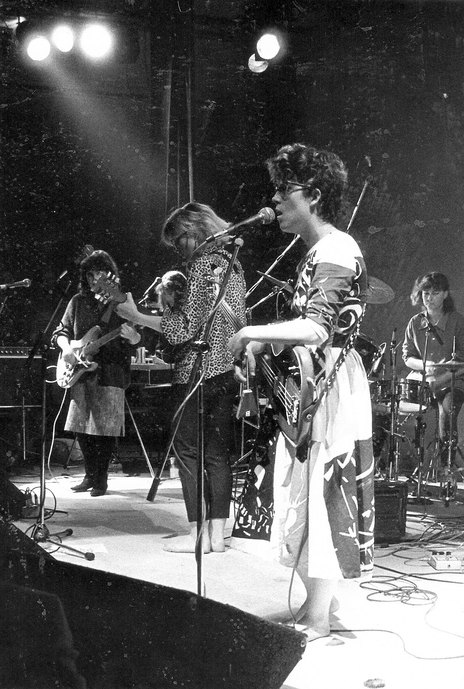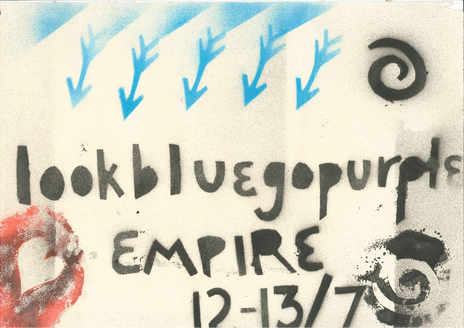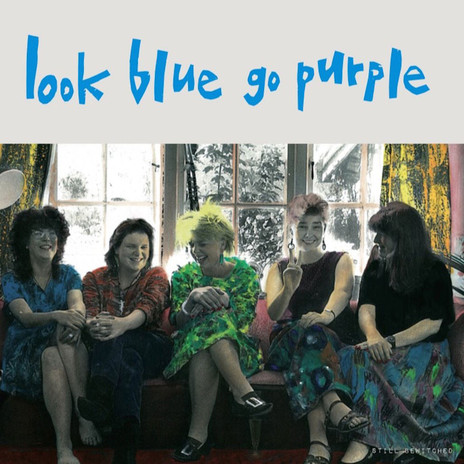It’s early 1987 in Dunedin’s Chippendale House, up a hilly rise south of the city’s Octagon heart. Inside the high-ceilinged Stafford Street warehouse arts venue, shows crammed with performers from the city’s bulging creative pool are playing out over two nights.
Three acts stand out. In A Circle, who were pencilled in for the second (unreleased) Dunedin compilation, a pre-Cakekitchen solo set from Graeme Jefferies, and Look Blue Go Purple.
The all-women five piece have begun their final year. They are well established in Dunedin, and have twice charted in New Zealand, most recently in January 1987.
As they perform on the wide, low stage at the far end of the cavernous warehouse, a giant picture of Andy Warhol’s head is projected onto one of the venue’s stark white walls. It’s promptly engulfed by a purple and yellow blob from the oil wheel that is adding a layer of unpredictable colour to the base image. The underlying picture changes to a shot of the Otago Peninsula, an indelible transposing of 1960s influence and the local environment, both near to the heart of the new Dunedin groups.
Labour Pains
Look Blue Go Purple rose, as so many Dunedin groups of the time did, from the roil of post-punk activity in the early 1980s. They were friends with, and sometimes girlfriends of, prominent members of the rising new groups.
“[It was] an amazing pool of amazing people who just played music. And welcomed anyone who wanted to play music. We were a social group as well,” LBGP bass player Kathy Bull (now Francisca Griffin) told Auckland student radio station 95bFM in 2012.
An early shuffling of the pack saw Lesley Paris drumming with The Neanics and Craven A’s with boyfriend Terry Moore, David Kilgour and Peter Gutteridge. “We had a kind of Velvet Underground thing going on. I’d always loved Maureen Tucker’s drumming,” Lesley Paris recalled to academic Ian Chapman in Kiwi Rock Chicks, Pop Stars & Trailblazers in 2010.
Canadian-born Bull (bass) and Norma O’Malley (keyboards, vocals) were in Permanent Tourists with Martyn Bull (The Elevators, The Chills). But there was a desire to create and play with other women. Enter Denise Roughan (guitar, vocals) and Kath Webster (guitar, vocals), an Otago University student from the Waikato in the North Island.
“Denise and I flatted together and we had two friends who had been playing in another band together (Kathy and Norma). [They] had a friend [Kath Webster] who was moving to Dunedin and owned her own guitar,” Paris remembers.
LBGP didn’t want to be defined as women’s music alone.
LBGP didn’t want to be defined as women’s music alone. Women making adventurous music in non-typical roles in the wake of punk was an established fact in New Zealand, as it was elsewhere, and as active music fans the group knew this.
“Of the English post-punk bands, The Slits and The Raincoats were the biggest influences on me when I started playing, and still are,” Paris told Chapman. “Both bands took off from that DIY spirit of the 1970s punk scene and sounded like nothing else around. Best of all they sounded like they didn’t care they sounded that way.
“There was a refreshing freedom to how they made music with song structures that were creative and unpredictable. Even though musically Look Blue Go Purple didn’t sound much like them, I think these bands were an inspiration to get together and write and play music on our own.”
But these were political times and gender and its place in the interpretation of their motivation and music would always be a big part of the discourse around Look Blue Go Purple. It dominated their interviews in much the same way as place and identity were soon to dominate analysis of the city’s other groups.
This vexed and irritated LBGP no end. They may have made a deliberate decision to create with other women, and later played women’s only events in Dunedin and with all-women groups such as Vibraslaps, but it was more about local community and music than gender.
Bewitched
When Look Blue Go Purple first came together in early 1983 their sound was rough. It was vocal and rhythm driven, as their second show, at Punakaiki Festival on the South Island’s West Coast in April 1983 and early live recordings attest. Two songs, ‘I’ve Been To Ena’s’ and ‘Labour Pains’, were captured on tape at Canterbury University on August 16, 1983 and released on Songs From The Lowland in 1984. ‘I’ve Been To Ena’s’ survived in LBGP’s live set until at least August 1985.
There was sly humour at work there as well. An early article in Otago Daily Times has the group as Maxine Berlin (O’Malley), Virginia Stirling (Bull), Lime Slyme (Webster), Polly Montgomery (Roughan) and Zena Neanic (Paris).
By 1984 they were ready to take their sound out of the South Island.
Being near the heart of a rising scene in Dunedin, Look Blue Go Purple had plenty of time to settle on instruments, write songs and hone their performance before leaving the protective shield of their home base. But by 1984 they were ready to take their sound out of the South Island.
Following dates with Doublehappys at the Captain Cook in May and an Otago University four band hop with The Verlaines, The Chills and Doublehappys in mid-June, LBGP headed north in December. On a varied bill typical of the time, the group played two dates at The Windsor Castle with The Rip, Say Yes To Apes and Fetus Productions on the 7th and 8th.
They were back in Auckland in February 1985 for Zippy’s Last Tour with The Chills and sometimes The Verlaines, The Bats and Able Tasmans, taking in New Zealand’s universities — a not always edifying experience, as LBGP found on more conservative campuses like Massey University in Palmerston North and Lincoln University near Christchurch, which they crossed off future touring programmes.
After Dunedin shows in late February with Wreck Small Speakers on Expensive Stereos at the Oriental Tavern and at Otago University, LBGP were back in Auckland at month’s end to record their first EP for Flying Nun Records, Bewitched.
Funded by a QE II Arts Council recording grant, the debut EP was taped and produced by Terry Moore using Bill Latimer’s equipment from The Lab studio, in an office building that was a functional factory for Jansen Audio. The group borrowed former Split Enz drummer Paul Crowther’s kit for the session, which was mostly first takes.
Then it was home again, bouncing back up to Christchurch for Gladstone dates with The Chills, Sneaky Feelings and Skeptics in early April. When they headed north in August 1985 via Wellington for shows at the Windsor Castle in Auckland, the record was just about out.
Bewitched climbed to No.21 on the pop chart in early September and stayed in the Top 50 for eight weeks.
Housed in a memorable purple, black and white sleeve with a pattern borrowed from the textile design on a member’s dress, Bewitched climbed to No.21 on the pop chart in early September and stayed in the Top 50 for eight weeks. The group remembers the EP selling out its first 750 copy run in 10 days.
Two songs on Bewitched stand out. The ethereal ‘As Does The Sun’ pulls something special out of the mid-1980s air, the chilled grace and underlying power of its flute and guitar leaving a timeless, otherworldly feel in its wake. ‘Circumspect Penelope’ is a little more present, but no less captivating.
“It’s the story of Odysseus and Penelope,” Kath Webster told The NZ Listener in 1985. “She was expected to wait for Odysseus for 20 years and she wove all that time, saying she’d never marry while her weaving was unfinished. She undid it at night, though.”
Pat O'Neill’s reflective filmic video had the group hauling up and over the Otago Peninsula in an old car, intercut with scenes of the band performing in masks at a party.
“It’s a flighty, evenly meshed pop, riding on an interplay of elements, rather than anyone trying to dominate. Concise with no let up,” Richard Langston wrote in Garage 4 in an article titled Purple Patch, which also included this exchange of views:
Denise: “When we were recording at The Lab one of the engineers asked, ‘Where have I heard that guitar sound before?’ ”
Kathy: “The way you play guitar reminds me of the way Wayne [Elsey – Doublehappys, Bored Games] strums and the way Graeme [Downes – The Verlaines] strums.”
Lesley: “And the way Lou Reed strums!”
Denise: “I suppose I have heard so many songs like that, you play like that. It’s not a conscious thing.”
I wonder what Jonathan Richman thought about that strum when they supported him in Christchurch on October 4, 1985 at the Gladstone? After a show at Dunedin in The Cage with The Alpaca Brothers and Government Life on December 4, LBGP returned to Christchurch for post-Christmas shows with The Pterodactyls, then joined The Verlaines and Roy Montgomery at Chippendale House to see out what had been a successful, breakthrough year.
Cactus Cat
Another year. Another orientation tour. 1986’s Strawberry Sound with Sneaky Feelings to be exact. Kicking off at Otago University, the groups headed up the islands to Auckland for dates at Auckland University and the Windsor Castle. By then the Queen City had its own echo indie guitar scene in Goblin Mix, The Exploding Budgies, Battling Strings, Bird Nest Roys and Alfalfa Louts.
By 1986 the Empire Tavern in Dunedin was in decline as a music venue. The city’s groups were stepping up to bigger rooms at Chippendale House and the Oriental Tavern, venues where you’d find Lesley Paris and Norma O’Malley in the best of George Henderson’s early The Puddle line-ups.
On before the original three-piece Straitjacket Fits of Shayne Carter, David Wood and John Collie, who played a fiery punk-ish set at Chippendale House on a Sunday, the narcotic Puddle opened. George Henderson played guitar, with The Clean and Great Unwashed guitarist Peter Gutteridge on keyboards, Norma O’Malley on flute and Lesley Paris on drums. Ross X (Jackson) held it all together on bass as they let loose a jazzy, propulsive psychedelia that sounded like the instrumentals on The Chocolate Watchband’s Inner Mystique. O’Malley could also be heard on The Alpaca Brothers’ EP of that year, another group that Paris sometimes drummed in.
July saw LBGP at Otago University for a memorable night with This Kind Of Punishment, The Rip and the touring Bird Nest Roys on the 18th. The following weekend LBGP were back at the Oriental for two nights. Then it was north with Terry Moore in tow to record their second EP. The pressure was on. Bewitched was a left field surprise for many, but now there were greater expectations.
LBGP2 climbed to No.26 in January 1987, propelled by the infectious folk pop of ‘Cactus Cat’.
In Auckland’s 16-track Progressive Studios, a more studio-confident LPGP dipped into their impressive swag of songs while Terry Moore threw in some tricks of his own, including backwards guitar on one track, “which everyone had read about and appealed aesthetically”. Recorded “in layers”, it’s an EP the busy Moore liked a lot, even if it took 11 hours to record the bass line on ‘Cactus Cat’.
The public agreed. LBGP2 climbed to No.26 in January 1987, propelled by the infectious folk pop of ‘Cactus Cat’. The EP stayed in the pop charts for five weeks.
‘Cactus Cat’ was Denise Roughan’s song, the first she brought to the band in its entirety, although ‘As Does The Sun’ was mostly her composition. The Cactus Cat in question is her part Burmese, part Russian Blue black cat named Yosser (a character from TV show Boys From The Black Stuff). Like most of their songs, the ‘Cactus Cat’ back-story has a number of bits. In this case taken from a book about mystical beasts and a Peruvian Mescal bottle label that also inspired the colourful cover art. That’s Yosser in Pat McNeill’s evocative video of ‘Cactus Cat’ amid Dunedin street scenes and Roger Gillespie’s impulsive graphic squiggles.
The EP’s other standout song is Kath Webster’s ‘Winged Rumour’ with Denise Roughan’s vocals, a contemplative swirl of flute, flighty strummed guitar and Lesley Paris’s constant upbeat.
“Winged Rumour’ was from a scene in Virgil’s Aeneid. ‘Winged Rumour flies faster than bushfire’ is kind of the key line and that was a line from the Aeneid or it might have just been an image from the Aeneid, but it just really appealed to me. That idea of gossip going mad like wildfire,” Webster recounted in 2012. Both Webster and Roughan had studied classical literature at Otago University.
That said, the mesmerising and enchanting ‘Hiawatha’, ‘100 Times’ and ‘Grace’ were no duds either.
This Is This
With the second EP out of the way, Look Blue Go Purple hit a crossroads. There was talk of Lesley Paris leaving for London, a trip that didn’t eventuate. In February 1987, LBGP headed to Auckland again for The Chills' farewell concert at the Galaxy, with Straitjacket Fits and Sneaky Feelings.
RipItUp reviewed the show, noting LBGP’s “silvery, skirling effects with flute, guitars and mellifluous contralto voices, pegged down by a hard working bass player, oddly discrepant with their dynamic fast paced drummer,” and that the group were popular with the crowd.
The show was a prelude to an extensive New Zealand tour with Straitjacket Fits. After performances in Auckland, Hamilton, Palmerston North and Wellington, South Island shows followed in the small provincial towns of Takaka, Motueka, Westport and Blackball, and in the city of Christchurch.
“They like reading in the bath, Tolstoy, flowers and baby animals, The Cramps, Zola, Bobby Gentry and lots of peace and love. They hate moustaches, olives, crimplene and lead breaks, and drink a flagon of port every practice. They practise three times a week every week,” read the tour blurb for Look Blue Go Purple.
Back in Dunedin, Look Blue Go Purple were joined by The Benders and David Kilgour’s Stephen at new venue, the Burgundy Bar in the European Hotel just off the bottom of the Octagon.
That year LBGP were one of three groups filmed for a Radio With Pictures special recorded live at Avalon studios.
That year LBGP were one of three groups filmed for a Radio With Pictures special recorded live at Avalon studios in Lower Hutt. Little of the band’s live power was captured outside their take on Janis Joplin’s take of Buffy Sainte-Marie’s ‘Codeine’ [sic], which had a solemn bite to it.
The clock was winding down for Look Blue Go Purple when they joined a line-up at the Oriental Tavern in late October, which showed the city’s musical strength was far from exhausted. Trash, The Puddle, Seedcake, Son of Goblin Mix and Mr Big Nose were on stage over two nights.
Look Blue Go Purple disbanded later that year. Their third EP, This Is This contained yet another highpoint, ‘I Don’t Want You Anyway’, and was released post-breakup in a striking sleeve by Ronnie van Hout. The EP was recorded by Peter Jefferies and Tex Houston.
Shrew’d
It didn’t end there. It rarely does with groups as good as Look Blue Go Purple. Kathy Bull was in Cyclops in the early 1990s and played and recorded with Peter Jefferies, Shayne Carter and Sandra Bell. She contributed ‘Eyes Are The Door’ to the Peter Jefferies compiled and recorded Killing Capitalism With Kindness on Turbulence Records in 1991 and ‘Antarctic’ to Flying Nun Records’ 1993 Shrew’d compilation of women musicians.
Norma O’Malley was a central figure in Chug in the early to mid-1990s. She contributed ‘Some Tame Gazelle’ to Killing Capitalism With Kindness and the best LBGP song the group never recorded, ‘Cruella’, to Shrew’d. Her version of another LBGP song, ‘Ralta’ with Lesley Paris (as Lesley Z. Paris) drumming appears on the Dunedin 1996 historical compilation, But We Can Write Songs Okay.
Lesley Paris was in Buster and Olla, and moved to Auckland in the 1990s to manage Flying Nun Records.
Denise Roughan teamed up with David Mitchell for ‘Jewel’ on Killing Capitalism With Kindness. Their Xpressway Records single Dead Dog In Port Chalmers contains a fine cover of the traditional ‘Grey Funnel Line’. Roughan and Mitchell would be a key part of The 3Ds and later The Ghost Club. Roughan also contributed ‘To Sleep, To Dream’ to Shrew’d with Norma O’Malley on flute, and played bass and drums on Maryrose Crook’s 'Timebomb'.
Kath Webster contributed ‘Easily Pleased’ with Lesley Paris on drums to Shrew’d. She could be seen and heard singing a song with the refrain “sick of the same old places” with Clapometer in the late 1980s, after leaving Dunedin.
In April 2017, Flying Nun issued Still Bewitched, a compilation of the band's work with five unreleased live tracks.
